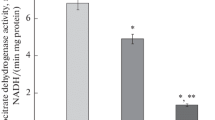Summary
The effect of inhibition of gluconeogenesis without effecting lipolysis on ketogenesis in starved rats is investigated. Inhibition of PEP-carboxykinase by i.p. injections of L-tryptophan leads to a rapid decrease of ketone body production. In the same manner the ketogenesis during infusions of caprylate is inhibited by L-tryptophan. During inhibition of gluconeogenesis by infusions of ethanol, however, the ketone production raises. Since ethanol is known to cause a decrease of liver oxaloacetate by increasing the lactate/pyruvate ratio, whereas inhibition of PEP-carboxykinase causes an increase of oxaloacetate levels, the results indicate that oxaloacetate is the link between gluconeogenesis and ketogenesis and ketogenesis is the result of a competition between gluconeogenesis and citrate synthesis for oxaloacetate. Glucose, fructose, sorbitol, xylitol, and glycerol inhibit the ketogenesis induced by infusions of caprylate. This shows an antiketogenic effect of these compounds in the liver, independent of their action on lipolysis. It is assumed that this effect is the result of inhibition of gluconeogenesis and/or production of oxaloacetate, whereas the formation of glycerolphosphate is of minor importance.
Zusammenfassung
Es wird untersucht, wie sich isolierte Hemmung der Gluconeogenese ohne Beeinflussung der Lipolyse auf die Ketogenese hungernder Ratten auswirkt. Hemmt man die PEP-Carboxykinase durch i.p. Injektion von L-Tryptophan, so sinkt die Ketonkörperproduktion rasch ab. In gleicher Weise wird durch L-Tryptophan die Ketogenese bei Caprylatinfusion gehemmt. Hemmt man dagegen die Gluconeogenese aus Lactat durch Äthanolinfusionen, so steigt die Ketonkörperproduktion an. Da bekannt ist, daß unter Äthanolinfusionen die Oxalacetatkonzentration in der Leber wegen der starken Erhöhung des Lactat/Pyruvat-Quotienten absinkt, bei Hemmung der PEP-Carboxykinase aber ansteigt, sprechen die Befunde dafür, daß der enge Zusammenhang zwischen Gluconeogenese und Ketogenese durch Oxalacetat vermittelt wird und daß die gesteigerte Ketogenese aus der Konkurrenz von Gluconeogenese und Citratsynthese um Oxalacetat resultiert. Glucose, Fructose, Sorbit, Xylit und Glycerin hemmen die durch Caprylatinfusionen induzierte Ketogenese. Das zeigt, daß diese Verbindungen einen von der Wirkung auf die Lipolyse unabhängigen antiketogenen Effekt in der Leber haben, der vermutlich durch Hemmung der Gluconeogenese und/oder Produktion von Oxalacetat zu erklären ist. Die Bildung von Glycerinphosphat ist dagegen von untergeordneter Bedeutung.
Similar content being viewed by others
Literatur
Foster, D. O., Ray, P. D., Lardy, H. A.: Paradoxical in vivo effect of L-tryptophan on the phosphoenolpyruvate carboxykinase of rat liver. Biochemistry5, 563–569 (1966).
Garland, P. B., Shepherd, D., Nichols, D. G., Ontko, J.: Energy-dependent control of the tricarboxylic acid cycle by fatty acid oxidation in rat liver mitochondria. Advanc. Enzyme Regulation6, 3–30 (1968).
Krebs, H. A.: The regulation of release of ketone bodies by the liver. Advanc. Enzyme Regulation4, 339–353 (1966).
—: The effect of ethanol on the metabolic activities of the liver. Advanc. Enzyme Regulation6, 467–480 (1968).
Stein, G., Bässler, K. H.: Mikromethode zur enzymatischen Bestimmung von Acetessigsäure und D-(−)-Β-Hydroxybuttersäure in Blut und Geweben. Z. klin. Chem.6, 27–30 (1968).
Veneziale, C. M., Walter, P., Kneer, N., Lardy, H. A.: Influence of L-tryptophan and its metabolites on gluconeogenesis in the isolated perfused liver. Biochemistry6, 2129–2138 (1967).
Wieland, O.: Ketogenesis and its regulation. In: Advances in Metabolic Disorders, Bd. 3, S. 1–47. New York: Academic Press 1968.
Williamson, J. R., Browning, E. T., Olson, M. S.: Interrelations between fatty acid oxidation and the control of gluconeogenesis in perfused rat liver. Advanc. Enzyme Regulation6, 67–100 (1968).
Walter, P., Paetkau, V., Lardy, H. A.: Paths of carbon in gluconeogenesis and lipolysis. III. The role and regulation of mitochondrial processes involved in supplying precursors of phosphoenolpyruvate. J. biol. Chem.241, 2523–2532 (1966).
Author information
Authors and Affiliations
Additional information
Wir danken der Jacques Pfrimmer-Gedächtnisstiftung in Erlangen für die Unterstützung dieser Arbeit durch eine Sachbeihilfe.
Rights and permissions
About this article
Cite this article
Bässler, K.H., Brinkrolf, H. Die Rolle von Oxalacetat bei der gesteigerten Ketogenese und beim antiketogenen Effekt. Z. Gesamte Exp. Med. 156, 52–60 (1971). https://doi.org/10.1007/BF02052976
Received:
Issue Date:
DOI: https://doi.org/10.1007/BF02052976




